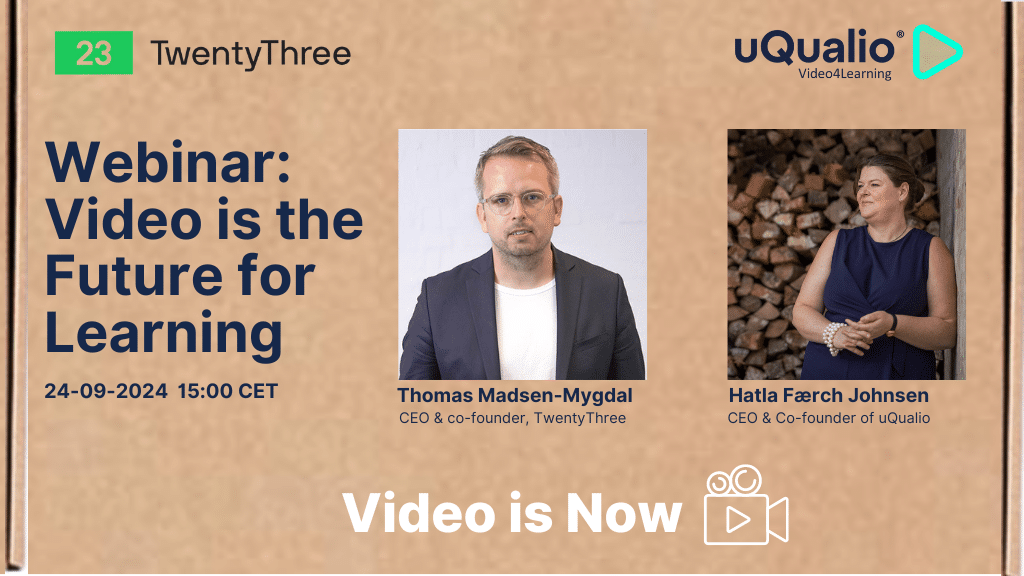The post-pandemic world quickly switched to eLearning from traditional classrooms, leading to an abrupt surge in the popularity of online video learning platforms over the last three years. Nearly 90% of academic institutions embraced online video learning platforms by April 2020. More than 40% of students think online learning is better than traditional classrooms, and almost 90% of organizations use eLearning platforms for employee training. Let’s explore why video-based eLearning is considered the future of education.
The Top Reasons Why Videos Are the Future of Education and Training
Here are some major reasons why video eLearning platforms are the future of education and training.
#1 Cost-Effectiveness
Cloud-based video learning platforms usually come with the pay-as-you-go pricing model – which means that you just pay for what you use with the option to upgrade or downgrade in the future. Some video eLearning software solutions do offer exclusive discounts too. For instance, uQualio offers its white-label platform at up to 50% discount to startups – and for NGOs, it’s free! Besides, learners can save money on commuting and study materials, which is usually an unavoidable cost associated with traditional classroom learning.
#2 Easy Accessibility
A computer or any smart device, along with an active internet connection, is all you need to access your preferred courses on video training platforms, which allows you to learn on the go. Globally, 58% of employees prefer to learn at their own speed. An online learning platform allows anyone to access courses from anywhere at their convenience – whether they are at home, working, or traveling. With the uQualio video learning system, one can even generate QR codes for specific courses that can be added to products to allow quick access to small bite-sized videos.
#3 Flexibility
Online video tutorials are created and uploaded to the system of video training platforms, which means that they can be accessed from anywhere and at any time. So, it doesn’t need scheduling a virtual (or physical) class, where learners and teachers meet at a predefined time. This offers better work-study and work-life balance to students and employees, respectively. You can also add, update, or change the video while the link stays the same.
#4 Improved Learning Experience
Worldwide, 44% of workers think eLearning is an effective way to learn. A white-label video training platform like uQualio allows anyone to learn and complete courses at their own pace. They are not required to be present in the physical classroom. Nor do they need to be available at a specific time for the live online class, each day. They can view eLearning content and learn without any time restrictions. To further ease accessibility and ensure just-in-time learning, uQualio generates course-specific QR codes that your learners can easily scan to access the course on any device. Moreover, while microlearning enhances retention, gamification in education boosts engagement and motivation, leading to better learning outcomes. A recent survey revealed that around 95% of employees enjoy using gamified systems, and using game-based motivation increases engagement by up to 48%.
#5 Customizable Video Learning Platforms
A white-label video training LMS like uQualio offers complete platform customization, ranging from system settings, user permission, and branding elements, to REST API, iFrame embedding, and standalone (headless) solution. Such customizations allow you to give the video LMS the look and feel of your own brand.
#6 Wide Range of Features
The majority of educators and teachers as well as nearly all training institutes are moving to the online space. Industry trainers and experts have also begun sharing eLearning content on digital learning platforms to upgrade and/or upskill. This has facilitated the emergence of various premade of-the-shelf virtual learning materials on a wide variety of topics and concepts for people with varying interests and professional experiences.
Video training platforms provide companies and organizations with various features and integration solutions. These help them meet the varied needs of their diverse learning communities, including employees, end-users, channel partners, extended enterprises, etc. For instance, despite being simple and easy-to-use, uQualio offers several advanced features. The features range from content authoring tool, bite-sizing tool, QR code, gamification elements (like quizzes, levels, and badges), to platform branding, API integration, headless (standalone) solution, iFrame embedding, AI-powered content generation, and many more to make things super-convenient, both for learners and course creators.
#7 Increased Demand for Online Video Training in the Post COVID-19 Era
This is another compelling reason why video training solutions are considered the future of education. When the entire world began shifting to digital in the post-pandemic times, the demand for video eLearning platforms surged considerably. Businesses and educational institutions have adopted various online learning approaches for top-notch remote learning experience. Microlearning is one such technique that has proven to be highly effective with respect to learning and retaining information. Microlearning has been proven to enhance retention rates by up to 60%. Moreover, a 10-minute microlearning course has a completion rate of 83%, compared to 30% for standard learning.
#8 Higher Retention Rates
In general, cloud-based video training platforms have higher retention rates, compared to conventional classrooms and learning material. According to Forbes, users perceive and retain 90% of the information they receive via video versus text. This can be ascribed to lower financial burden, easy accessibility of virtual training material, and the convenience of viewing and completing courses at one’s own pace. Learners can revisit the eLearning content just when they need it – and as many times as they want.
Course creators can also create video training in just a few clicks. Plus, they can distribute their content in multiple ways that make the course easily accessible for their learners. For example, on uQualio, you can create a QR code for a specific course on how to use your product. This code can be shared with your end-users or customers. So, your end-users can instantly access the course, exactly when they are using the product – which ensures just-in-time learning.
#9 High-Quality Interaction
Trainers and teachers can make use of varied eLearning strategies and choose who can see what. Trainers with admin roles can track user progress and the performance of their courses via reports and analytics. Moreover, learners can share their feedback on the courses assigned to them, which helps ensure continuous course improvement. This boosts student-teacher interaction, as the teacher can focus on individual students, which is a major challenge in a jam-packed physical classroom.
To Conclude
With the discussion above, it is crystal clear that traditional teaching methods are not the only way to make students and professionals learn and grow. Educators and trainers from various backgrounds are constantly on the lookout for newer eLearning strategies and methods to match their learner’s needs.
The best thing about eLearning is that it allows learners to figure out what their specific requirements are, what interests them, what kind of virtual training they are comfortable with, and which online approach works best for them.
While it was the pandemic that forced the whole world to embrace online learning, it has actually worked wonders for everyone. In light of the growing popularity of online video learning, ongoing learning trends, and forecasts, online video learning platforms are unarguably the future of education.
Achieve Effective & Affordable Video Training
– uQualio is an award-winning, easy-to-use, all-in-one NextGen LMS software for any types of online video training.












